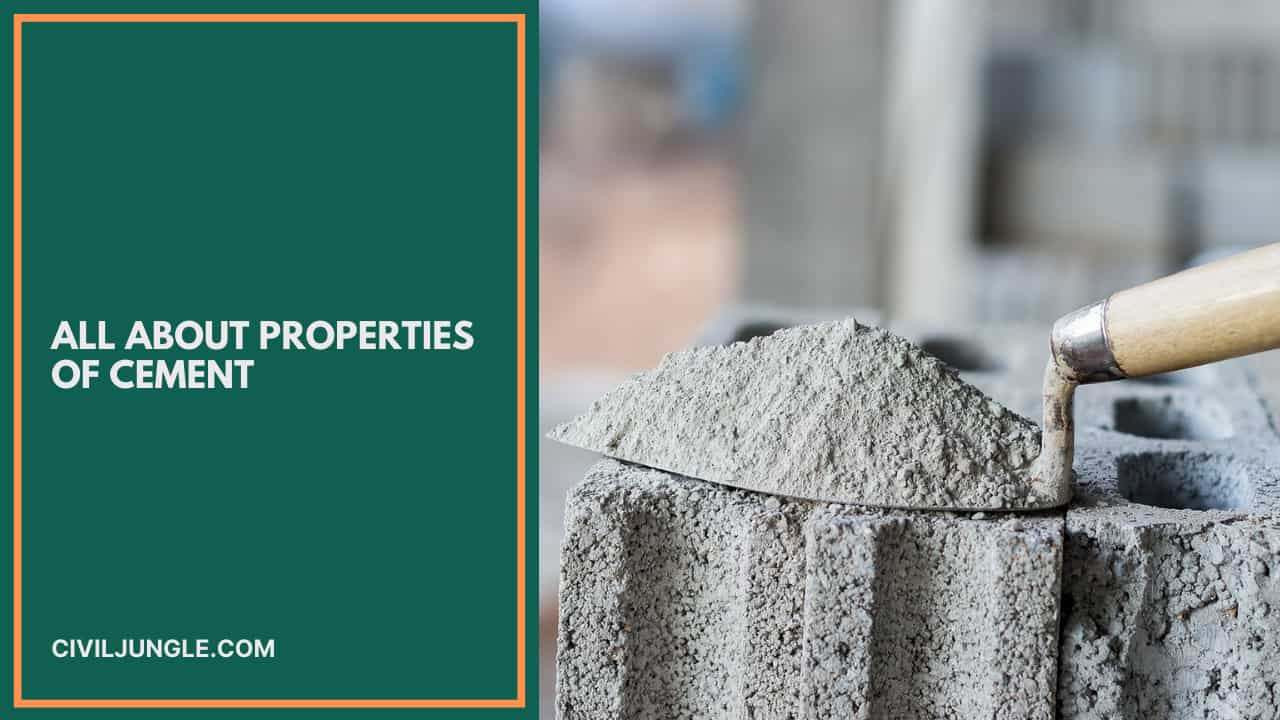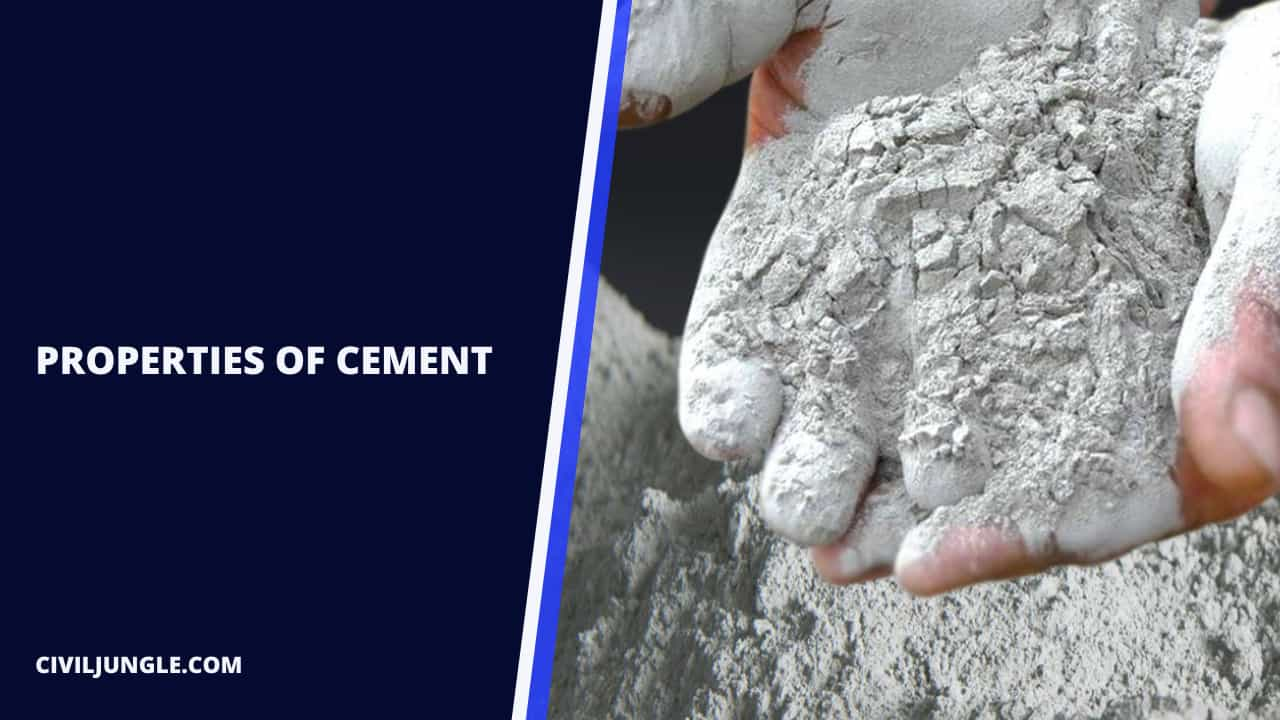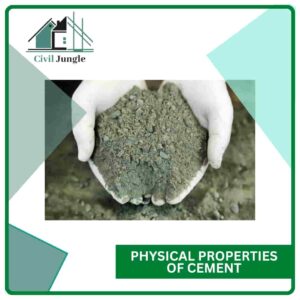Introduction of Properties of Cement
Important Point
Cement is one of the most widely used building materials in the construction Industry. Almost every type of construction required the use of cement.
Cement is basically used as a binding material and it is one of the important civil engineering construction materials. Cement has various Physical as well as Chemical properties.
As a Civil engineer, it is important that you should know the various physical and chemical properties of cement and the method which is used to test the properties of cement.
In this article, we will going to discuss the properties of cement and the different tests which are used to determine the properties of cement.
Type of cement and its physical and chemical properties depends on the type of construction work. It is important that the cement should fulfill the standard parameters which are given by the Bureau of Indian Standards.
Also, Read:Density of Cement Sand and Aggregate
Properties of Cement
Here two different types of properties of cement are as follows.
- Physical Properties of Cement
- Fineness of Cement.
- Standard Consistency of Cement.
- Initial and Final Setting Time of Cement.
- Compressive Strength of Cement.
- Soundness of Cement.
- Hydration of Cement.
- Specific Gravity of Cement.
- Chemical Properties of Cement
- Tricalcium Silicate (C3S).
- Dicalcium Silicate (C2S).
- Tricalcium Aluminate (C3A).
- Tetracalcium Alumino Ferrite (C4AF).
- Lime.
- Alumina.
- Alkalis.
- Magnesia.
- Ferrite.
Also, Read: What Is PPC Cement
1. Physical Properties of Cement
Physical properties of cement in different types are as follows.
1.1. Fineness of Cement
Fineness of cement directly refers to the size of the grain or particles of the cement. The Fineness of the cement is one of the most important factors which affects the rate of hydration and the rate of gain of strength as well as the rate of evolution of heat in the cement.
Lesser the size of the grain, finer will be the same. Finer cement offers more surface area and hence the development of the strength in the cement is faster.
The reason for the development of more strength in finer particles of the cement is because the greater surface area is available for contact with water and the reaction of the hydration becomes faster and the cement will gain strength more rapidly.
The cement should have a maximum number of particles less than 100 microns. The smallest size of the particle of the cement is about 5 microns.
The particle size of the cement less than 3 micron affects the strength of one day while the size of the particle of the cement ranges from 3 to 25 micron has a major influence on the 28 days strength.
It is recommended that in commercial cement there should be about 25 to 30% of particles should be less than 7 microns in size.
The method which is commonly used for the determination of fineness of the cement are as follows
Sieve Test ( IS 4031, Part 1 1996)
The procedure of determining the fineness of the cement are as follows.
- Take 100 gram weight of sample of cement and take it on the standard sieve number 9 (90 micron sieve)
- Break down the air lumps which are present in the cement sample.
- Sieve the cement sample continuously for 15 minutes.
- After that there will be some residue will remain on this you take the weight of that residue of the cement.
According to the Indian standard
The weight of residue for the OPC (Ordinary Portland cement) should not exist than 10% of the weight of cement and the weight of residue for RHC (Rapid hardening cement) should not exist than 5% of weight of cement.
Also, Read: How Cement is Made
1.2. Standard Consistency of Cement
Consistency of the cement refers to the thickness or the thinness of the cement paste when the cement is mixed with water.
Standard consistency is defined as the consistency which will permit a standard Vicat plunger to penetrate at a depth of 33 mm to 35 mm from the top of the mould in a standard Vicat Apparatus.
Vicat apparatus is the instrument which is used to determine the percentage of water required to produce a cement paste for standard consistency. Standard consistency of the cement paste is also known as the Normal consistency of the cement.
It is very necessary that the Standard consistency test of the cement should be performed because the value of the standard consistency is used to determine the water content for other tests such as the Initial setting time and final setting time of the cement.
The Vicat apparatus is used for conducting three tests which are the standard consistency test, Initial setting time test, and final setting time test by changing the attachments.
1.3. Initial and Final Setting Time of Cement
Initial setting time and final setting time are one of the most important physical properties which are considered during the construction work.
It is very difficult and complex to exactly know the moment when the cement start losing its plasticity and hence it is a convenient but arbitrary limit is defined by the initial setting time test.
The Initial setting time of the cement is defined as the time which is elapsed between the moment when the water is added in the cement to the moment when the cement paste starts losing its plasticity.
The period elapsing between the time when water is added to the cement and the time at which the needle penetrates the taste block to a depth equal to 33 mm to 35 mm from the top is taken as initial setting time of the cement.
The Final setting time of the cement is defined as the time which is left between the moment when the water is added to the cement and the moment when V has completely lost its plasticity.
The final setting time test is conducted on the cement after in continuation of the initial setting time test and the same malt of the cement paste is used for the determination of this test.
Also, Read: Difference Between 33, 43 and 53 Grade Cement
1.4. Compressive Strength of Cement
Compressive strength is one of the most important properties of this cement. So it is important that the compressive strength of the cement should be checked.
The main function of the cement is to take the compressive load of the structures. The compressive strength test is performed on neat cement paste and the standard sand which is supplied from encore, tamilnadu.
1.5. Soundness of Cement
The soundness of cement defines as the stability of the volume change in the process of setting and hardening of the cement. The excess quantity of lime also causes the unsoundness of the cement.
It is the ability of the cement to retain its volume after get hardened. The cement which is properly sound will undergoes very less volume change after it converts into the hardened state.
The soundness of the cement is conducted by the Le-Chatelier method and Autoclave method.
If the cement is unsound then it shows large volume changes with respect to temperature after setting and hardening of the cement. Unsoundness of cement may be due to the excessive operation of the magnesia or sulfates.
1.6. Specific Gravity of Cement
Specific gravity is defined as the ratio of the density of a particular substance to the density of a reference or standard substance at a fixed temperature.
Specific gravity of cement is an important physical property that will help us to understand whether the material will sink or float in the water. It basically shows how much the substance is heavier than water or standard substance.
The specific gravity value for Portland cement is 3.15.
1.7. Heat of Hydration of the Cement
The cement comes in the dry powdered state in the bag. Cement is used as the binding material but its binding property get activated after the addition of water in it.
When the water is added in the cement, the chemical reaction takes place and it is an exothermic reaction between water and cement which liberate heat it due to which the cement gain its strength.
This reaction between cement and water due to which the cement acts as a bonding agent is called as hydration of cement.
Also, Read: How Many Cement Bags Per Square Metre for Plastering
2. Chemical Properties of Cement
During the manufacturing of Portland cement, the raw materials are subjected to high temperature which combines with each other and forms complex compounds. These compounds are known as Bogue’s compound.
2.1. Tricalcium Silicate (C3S)
The Tricalcium silicate is responsible for early strength in the cement. The Tricalcium silicate comprises 25% of 30% of cement.
Tricalcium silicate is generally used in the rapid hardening cement because of its early strength property. The quantity of Tricalcium silicate is increased in rapid hardening cement due to which it sets faster.
Tricalcium silicate has a heat of hydration of about 500 J/g.
2.2. Dicalcium Silicate (C2S)
The Dicalcium silicate is responsible for the progressive strength of the cement. The Dicalcium silicate is generally used in the construction of dam as well as Bulk concreting. Dicalcium silicate is used in the Low heat cement.
The Dicalcium silicate has a heat of hydration of about 260 J/g.
2.4. Tricalcium Aluminate (C3A)
Tricalcium aluminate is the first compound that is formed after the addition of water. Tricalcium aluminate is responsible for the early setting of the cement.
The Tricalcium Aluminate has the heat of hydration of 865 J/g. It gives the maximum heat of hydration and formed within 24 hours. Tricalcium aluminate is responsible for the Flash setting of the cement.
2.5. Tetracalcium Alumino Ferrite (C4AF)
Tetra calcium alumino ferrite is the second compound which is formed after the addition of water in the cement. Tetra calcium alumino ferrite of it has a heat of hydration of about 420 J/g.This will make the cement more resistant to seawater.
Also, Read: RCCFull Form
2.6. Lime
If the cement contains lime in excess quantity then it will cause the expansion of the cement and make it unsound.
Lime has been used as a binder in mortars for over 2000 years. Today, lime is still used as the primary binder in many mixes, usually in the form of lime putty or Hydraulic lime. Hydrated lime is used in modern cement-based mortars mainly for its properties as a plasticizer.
2.7. Alumina
The cement which contains a high quantity of animals has the ability to which time the frigid temperatures. It also helps in setting the cement.
2.8. Alkalis
The amount of potassium oxide(K2O) (K2O) and sodium oxide (Na2O) present in the cement determine the alkali content of cement. The cement which contains a large amount of alkalis can cause problem in setting time of the cement.
It is necessary that you should present in cement in proper quantity. When the alkali cement is used with the calcium chloride then it may cause discoloration.
2.9. Magnesia
Magnesia is used as a raw material in the manufacturing of Portland cement. The excess quantity of magnesia present in cement makes it on sound and expensive and little amount of magnesia in cement will add strength to the cement.
2.10. Ferrite
Ferrite is used as a fluxing agent in the cement and it helps to reduce the temperature of the raw material in the kilin. It does not contribute to the strength of the cement.
Also, Read: Pile Cap Design
Properties of Cement
- Fineness of cement.
- Soundness.
- Consistency.
- Strength.
- Setting time.
- Heat of hydration.
- Loss of ignition.
- Bulk density.
- Specific gravity (Relative density).
- Tricalcium aluminate (C3A).
- Tricalcium silicate (C3S).
- Dicalcium silicate (C2S).
- Ferrite (C4AF).
- Magnesia (MgO).
- Sulphur Trioxide.
- Iron oxide/ Ferric oxide.
- Alkalis.
- Free lime.
- Silica fumes.
- Alumina.
Chemical Properties of Cement
- Tricalcium aluminate (C3A).
- Tricalcium silicate (C3S).
- Dicalcium silicate (C2S).
- Ferrite (C4AF).
- Magnesia (MgO).
- Sulphur Trioxide.
- Iron oxide/ Ferric oxide.
- Alkalis.
- Free lime.
- Silica fumes.
- Alumina.
Physical Properties of Cement
- Fineness of cement.
- Soundness.
- Consistency.
- Strength.
- Setting time.
- Heat of hydration.
- Loss of ignition.
- Bulk density.
- Specific gravity (Relative density).
Setting Time of Portland Cement
The national standards prescribe that the initial setting time of Portland cement should not be earlier than 45 min and the final setting time should not be later than 6.5 h.
Hydration Process of Cement
The water causes the hardening of concrete through a process called hydration. Hydration is a chemical reaction in which the major compounds in cement form chemical bonds with water molecules and become hydrates or hydration products. Details of the hydration process are explored in the next section.
Durability of Concrete with Cement
Concrete durability depends upon the degree of exposure, the concrete grade (or strength) and the cement content. A high density, alkali-resistant concrete will better resist the effects of moisture penetration.
Setting Properties of Cement
Hence, two setting times are measured: Initial set: When the paste begins to stiffen noticeably (typically occurs within 30-45 minutes) Final set: When the cement hardens, being able to sustain some load (occurs below 10 hours)
Mechanical Properties of Cement
Typical properties of normal strength Portland cement concrete:
- Density – ρ : 2240 – 2400 kg/m3 (140 – 150 lb/ft3)
- Compressive strength : 20 – 40 MPa (3000 – 6000 psi)
- Flexural strength : 3 – 5 MPa (400 – 700 psi)
- Tensile strength – σ : 2 – 5 MPa (300 – 700 psi)
- Modulus of elasticity – E : 14 – 41 GPa (2 – 6 x 106 psi)
Characteristics of Cement
Properties of Good Cement
- Provides strength to masonry.
- Stiffens or hardens early.
- Possesses good plasticity.
- An excellent building material.
- Easily workable.
- Good moisture-resistant.
Properties of Concrete
The properties of hardened concrete
- Mechanical strength, in particular compressive strength. The strength of normal concrete varies between 25 and 40 MPa.
- Durability.
- Porosity and density.
- Fire resistance.
- Thermal and acoustic insulation properties.
- Impact resistance.
What Are the Properties of Cement?
Although desirable cement properties may vary depending on the type of construction, generally a good cement possesses following properties (which depend upon its composition, thoroughness of burning and fineness of grinding). Provides strength to masonry. Stiffens or hardens early. Possesses good plasticity.
What Are Various Properties of Cement Explain in with Salient Points?
Three types of strength of cement are measured – compressive, tensile and flexural. Various factors affect the strength, such as water-cement ratio, cement-fine aggregate ratio, curing conditions, size and shape of a specimen, the manner of molding and mixing, loading conditions and age.
What Are the Properties of Concrete?
For structural strength, the concrete in its hardened state must have the properties assumed for it in the design of the structure. The important properties of hardened concrete are strength, durability, impermeability, and volume stability.
Cementitious Materials
Cementitious materials are one of the principal ingredients that make up the concrete mixture. There are two types of cementitious materials: hydraulic cement and supplementary cementitious materials (SCMs). Hydraulic cements set and harden by reacting chemically with water.
Water Absorption of Concrete
Concrete absorption rate depends on E / C ratio. For E / C ratio less than 0.5, the average water absorption value of the concrete is between 5.5% and 6.5%.
Properties of Polymer Concrete
Properties
- The binder is more expensive than cement.
- Significantly greater tensile strength than unreinforced Portland concrete (since polymer plastic is ‘stickier’ than cement and has reasonable tensile strength)
- Similar or greater compressive strength to Portland concrete.
- Faster curing.
Like this post? Share it with your friends!
Suggested Read –
- Type Cement
- Opc Cement
- Buttress Dam
- Lime Vs Cement
- Consistency of Cement
- Types of Slope Failure
- Sand Chemical Composition
- What Is Soundness of Cement
- Top 10 Cement Companies in USA
- Top 10 Best Cement Companies In India 2021
- Top 10 Bathroom Fittings & Sanitary Brands India
- What Is Grouting | Types of Grouting | Advantage of Grouting
- What Does Parapet Mean | Types of Parapet Wall | Uses of Parapet Wall
- Cinder Block Vs Concrete Block | What Is Cinder Blocks | What Is Concrete Blocks
Originally posted 2023-07-28 12:14:11.





Leave a Reply